News & Blogs
What is Sansai (山菜)?
Edible mountain plants saved the Japanese from hunger.
Six iconic mountain vegetables in spring
A special menu at a restaurant in Jurassic Park.
In this blog, we touch on diverse topics about Japanese food cultures, practices together with the culinary secret, TREHA®, and its important role in the Japanese food industry. We hope our blog helps you obtain in-depth knowledge of the secrets and science behind Japanese cuisine, shared from our kitchen, to yours.
What is Sansai (山菜)? - Edible mountain plants
Japan has four distinct seasons. Because of it, Japanese people are known to value seasonal ingredients, which showcase the height of the flavors available in each season. When the plants and trees start to bud after a long, latent winter, the Japanese look forward to Sansai (山菜), mountain vegetables, a general term for edible plants that grow in the wild. Mountain plants organically grow in diverse environments, from seaside to alpine or from urban to the countryside. There are more than 300 varieties of wild plants eaten all over Japan.
Typical spring mountain vegetables include buds of Japanese angelica (Aralia elata), butterbur, and bracken. Sansai, featuring acridity, a unique bitterness, and an alkaline taste, is only available during spring in limited amounts. However, mountain plants have been loved since ancient times due to their unique flavors, enhancing spring feels.
There are several ways to procure mountain vegetables:
Hike to the mountains to collect them in person.
Purchase the mountain vegetables collected by someone else for commercial purposes.
Purchase commercially grown mountain plants (Technically speaking, they might not be “mountain” plants any longer.)
Since many poisonous plants with similar looks to the edible plants grow in the mountains, significant cases of food poisoning occurred by mistake. According to Japan's Ministry of Health, Labor and Welfare, fatal accidents have also happened in the past ten years. Therefore, it is highly recommended to be with someone knowledgeable as it is risky for amateurs to go alone when collecting these plants. My grandparents, experts of wild plants, often took me to the mountains owned by their relatives where the edible plants grow. They told me that a child has good vision and quickly crawls into the bushes, making them very helpful for collecting seasonal wild plants.
While East Asians have the custom to eat native plants similar to Japanese sansai mountain vegetables, the Westerners hunt mushrooms, berries, and herbs. The Japanese consume wild plants from the mountains like no other culture.
As the Japanese saying goes, "Serve bitterness on a spring plate,” the mountain plants’ unique bitterness and aroma come from plant-based alkaloids and polyphenols, which are thought to detoxify the body and promote metabolism by expelling wastes accumulated along with the nutrients to endure the cold weather. The Japanese rejoice at the arrival of spring and embrace the bitterness of seasonal mountain vegetables with bare minimum seasoning. We must have learned that bitter ingredients drain the toxins through experience since ancient times.
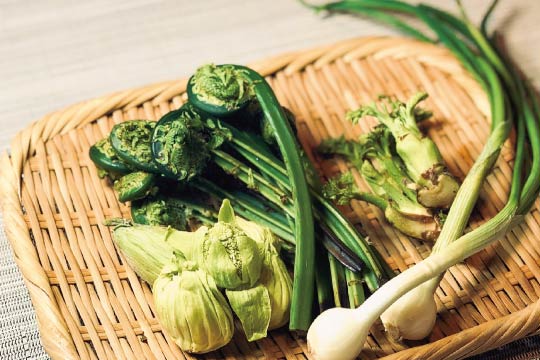
The Japanese have relied on mountain plants during difficult times.
It is believed that Homo sapiens migrated to Japan around 38,000 years ago. Later in the Neolithic period, known as the Jomon period (between c. 14,000–300 BCE), archeological findings indicate the ancestor of the Japanese often consumed mountain vegetables. About 40 species have been found in ancient ruins, including wild peach, sansho peppers, and wild rocambole. The discovery of the Japanese angelica seeds attracted public attention from the Sannai-Maruyama ruins (Aomori City), estimated to be 4,200 to 5,900 years old. It is assumed that more species could have been consumed than what was discovered because the buds of plants and trees are easily decomposed without leaving traces. The Jomon people removed the astringency of the plants or stored the pickled plants in their earthenware.
Later, between the late 7th and late 8th centuries, as many as 27 species of edible wild plants were described in the Man-yo-shu (万葉集), Japan's oldest anthology of poems. This indicates a variety of mountain vegetables were consumed at the time.
The records from the Edo period (1603-1868) indicate mountain vegetables saved many lives during famines caused by unseasonable weather or poor harvesting of rice and vegetables. Even as recent as in the 20th century, many survived through wartime and post-war food shortages with the bounty of the mountains in the form of wild edible plants.
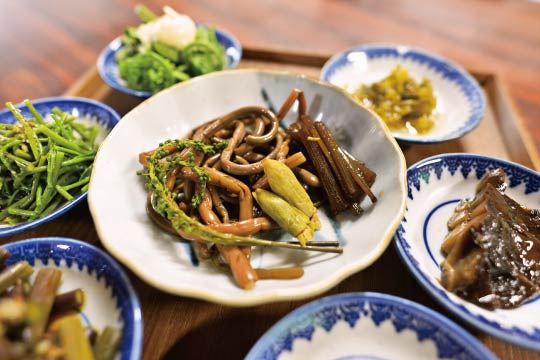
Six iconic mountain vegetables in spring
Thank you for being so patient. We introduce the representative spring mountain vegetables with some pre-treating and cooking tips. While they are often consumed as tempura because their bitterness is compatible with deep-frying, the wild plants make excellent non-Japanese dishes with high oil or fat content. (Click here for the tempura recipe with TREHA®.)
Japanese angelica buds (tara-no-me タラの芽):
Japanese angelica buds are considered the "king of wild plants.” The wild buds harvest from March to early April, while farmed buds are available from February to March. Fully developed buds with larger leaves are best for tempura as it is more fragrant and flavorful.
The hard husks need to be removed from the roots before cooking. While the husked and washed buds are ready to deep-fry for tempura, the buds should be blanched to remove the harsh taste for making Ohitashi (dashi infused vegetables) or Aemono (dressed vegetables). To prepare the buds, add 2% salt to the boiling water (tablespoon salt per 1 quart of water) for 2 to 3 minutes, then drain in cold water.
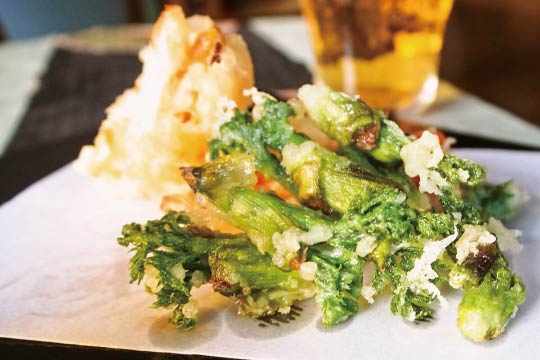
Butterbur buds (Fukinoto フキノトウ):
Butterbur is a perennial plant of the Asteraceae family, which pops out from the ground in early spring from February to May when the snow melts. It is one of the most iconic plants heralding the arrival of spring. Butterbur buds are characterized by a solid bitterness, which could be addictive to some epicureans. Small, tightly closed buds are suitable for cooking as the bitterness progresses when the flowers develop. Butterbur buds harvested from the snow-covered ground are flavorful and mild with low astringency.
To remove the harsh taste, boil the buds in 2% salted water for 3 to 4 minutes and then drain with cold water. If the buds are deep-fried for tempura, this process can be skipped.
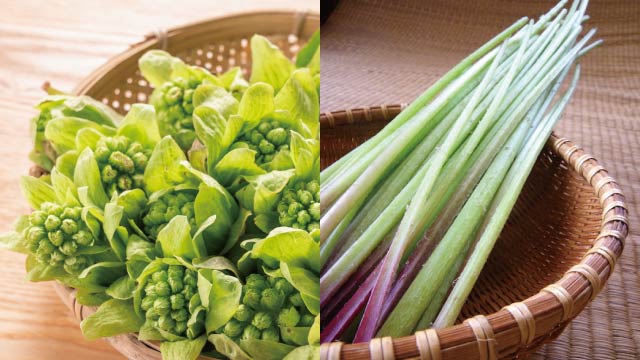
Bracken fronds (Warabi 蕨):
Bracken is a type of fern, a familiar wild plant growing in the mountains throughout Japan. Harvested from April to May, the young fronds feature a unique shape and crunchy texture. Bracken also produces the starch flour from its rhizome called "Warabi-ko,” used for Japanese sweets.
A firm stalk covered with lots of hair indicates the freshness of the frond. The key to making a flavorful dish depends on the pre-treatment to remove the harsh taste. Soak the bracken fronds in boiling water with baking soda, leave them overnight, drain off the water, and soak them in cold water for another half day to prepare them to use.
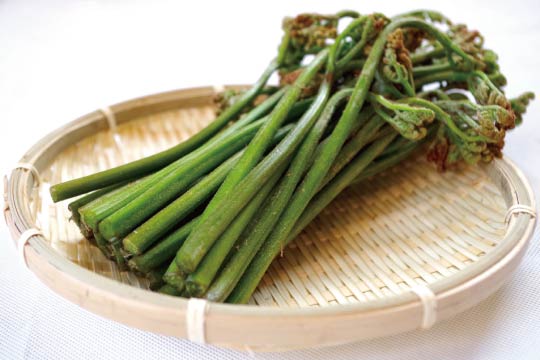
Angelica tree (Udo 独活):
Angelica tree is a perennial plant that belongs to the same family as Japanese angelica. The plant is used as a metaphor for someone too big to be helpful because its stems grow long like a tree but are too soft to serve as wood. However, the young shoots are fragrant, succulent, and delightful, featuring a rich flavor with a hint of bitterness and a firm, crunchy texture.
While the young shoots make a delicious tempura dish, I prefer fresh shoots dipped in miso paste. After being skinned and rinsed thoroughly, the new shoots are enjoyable as they have minimal harshness. If freshly harvested shoots are unavailable, peel the thick layers and soak them in water with vinegar. This will remove the acridity while enhancing a beautiful white color.
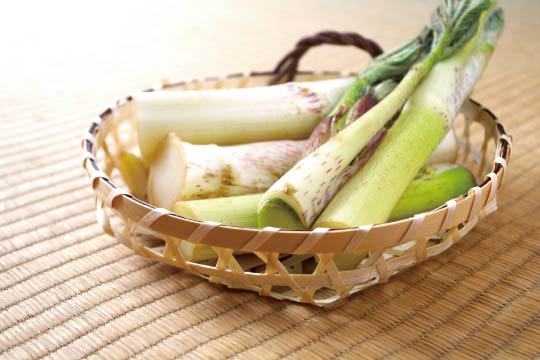
Devour the wild plants from the age of dinosaurs - Tree fern (Cyathea lepifera)
There is a gigantic sansai mountain plant called tree fern (Cyathea lepifera), which I am eager to try out.
It is a colossal fern (Hikagehegoヒカゲヘゴ) found in the areas including the main island of Okinawa and the Yaeyama Islands. A part of the hederaeceae family, the fern is nicknamed “a living fossil” that appeared about 100 million years ago. Surprisingly though, it is a relatively new variety among fern plants. The fern tree grows up to 50 feet tall, and the length of leaves can reach over 6 and 1/2 feet.
The edible parts are the shoots and trunk cores, served as tempura or sunomono salad after boiling to remove the harsh taste. The trunk core supposedly has a texture similar to daikon radish. The cooked fern core is an indispensable food item to celebrate festivals in the Yaeyama Islands. In Okinawa, the fern develops fronds from January to April in Okinawa. This motivates me to visit Okinawa for a vacation to try the most authentic paleo diet.
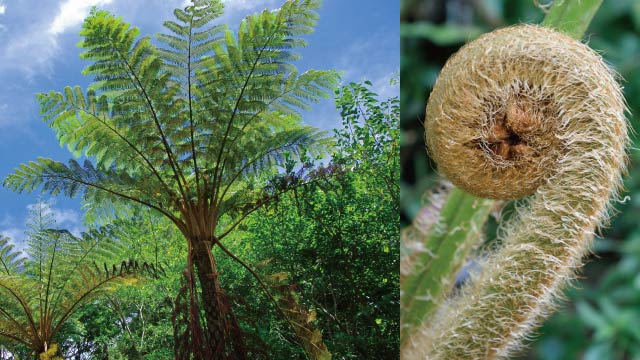
Sansai mountain vegetables are nature’s gift. As mentioned in the previous posts, the Japanese have found, and respected deities in nature and have appreciated a variety of harvests since ancient times. Today we still savor the edible mountain plants in spring thanks to the many generations’ efforts to cherish the tradition. The traditions will be appreciated and relayed to the following generations.
Please try extending your thought to the lush Japanese nature when you have a chance to taste Japanese wild vegetables.
Did you find this blog interesting?
Please share it with your friends in the food service industry.
We regularly update the blog about the food culture of Japan, where TREHA® was discovered for culinary applications.
Click here and send us a message to subscribe.
Or hit us up on Instagram @trehalose_sensei!
You might also be interested in:

